Effects of Alfalfa Husk and Alfalfa Pellets on the Gastric Mucosa of Weaned Horses(Part 1)
Date: 12/23/2020 08:45:53 From: feed-pellet-plant.com Clicks:
Abstract
Background
Feeding alfalfa hay is often recommended for its buffering components, like protein and calcium, to prevent lesions of the gastric mucosa in horses. Until now, there has been no information regarding the influence of alfalfa particle size on the gastric mucosa. The aim of this study was to investigate the effects of feeding two alfalfa preparations with different particle sizes (alfalfa chaff vs alfalfa pellets) in comparison with grass hay on the gastric mucosa in weanling horses. We hypothesized that feeding a high proportion of fine alfalfa particles would negatively impact gastric mucosa and that feeding long alfalfa chaff would improve gastric mucosal health in weanlings.
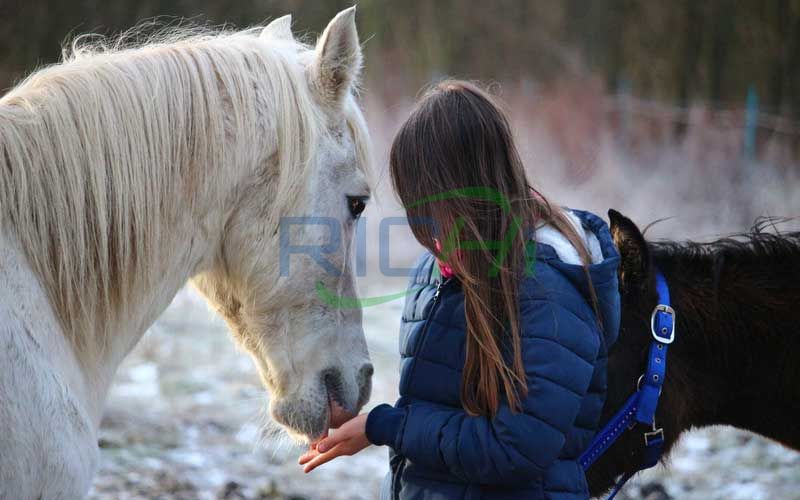
Effects of Alfalfa Husk and Alfalfa Pellets on the Gastric Mucosa of Weaned Horses
Results
Before weaning, the prevalence of gastric mucosa lesions (one or more lesions considering all locations in the stomach) was 84.3 %; at 14 days after weaning, it was almost 100 %. Before and after weaning, most of the lesions were found at the greater curvature of the squamous mucosa and at the lesser curvature. After weaning, gastric mucosal lesions at the pylorus were significantly more severe in the group fed alfalfa chaff (p = 0.002). In the other regions, no differences related to the feeding regimes were observed.
Conclusions
Feeding alfalfa failed to improve gastric mucosal lesion scores in weanlings. Furthermore, foals fed alfalfa chaff had higher lesion scores at the pylorus. Alfalfa leaves contain a superior protein source and high amounts of calcium and magnesium, providing extra nutritional advantages in growing horses. At this time, either traditional grass hay rations or grass hay with alfalfa pellets can be recommended.
Background
Gastric ulceration is commonly identified in horses and foals. The prevalence of gastric ulcers in Thoroughbred racehorses is estimated to be >80 % in the squamous mucosa [1]. In weanlings it ranges between 32 and 94 % [2, 3]. Risk factors for gastric mucosa lesions, specifically for equine squamous gastric ulcer disease, are stall confinement, strenuous exercise, transport stress in adult horses (as reviewed by Andrews and others [4]), and the weaning process in foals [2, 3]. Nonsteroidal anti-inflammatory drugs have been demonstrated to be a risk factor for the equine glandular region in adult horses and foals [5, 6].
The relationship between feeding and gastric mucosal health has been demonstrated. Dietary factors that may effect squamous gastric mucosa in horses include buffering substances [7], the level of starch intake [8], or the type and daily amount of food [8, 9]. Furthermore, the particle size of the diet appears to be a factor in glandular gastric mucosa [2]. In foals, feeding alfalfa chaff resulted in glandular mucosal lesions, which may have been related to mechanical irritation [2]. Furthermore, no favorable effect was found on the squamous mucosa in weanlings. However, other authors observed beneficial effects of feeding alfalfa hay on the squamous mucosa in foals [10] and adult horses [7]. In pigs fed a diet of finely ground pellets, the squamous gastric ulcer score was significantly higher than for those fed a diet of larger particles [11]. Furthermore, feeding a coarse ground feed reduced mucosa lesions of the pars oesophagea in growing pigs [12].
The aim of this study was to investigate the effects of feeding two alfalfa preparations with different particle sizes (alfalfa chaff vs alfalfa pellets) in comparison with grass hay on the gastric mucosa in weanling horses. We hypothesized that feeding a high proportion of fine particles (alfalfa pellets) would negatively impact gastric mucosa in foals and that foals receiving alfalfa chaff would have better gastric mucosal lesion scores.
Results
None of the foals in the study demonstrated any clinical signs commonly associated with the presence of gastric ulcers such as colic, inappetence, or depression, as reviewed by Andrews and others [4].
The daily average consumption of grass hay per foal was 4.3 kg in the alfalfa chaff group, 5.0 kg in the alfalfa pellets group, and 8.3 kg in the grass hay group (Table 1). In addition to the grass hay intake, the mean daily feed intake (± SD) was 5.95 ± 0.13 kg in the alfalfa chaff group, 5.47 ± 0.18 kg in the alfalfa pellets group, and 3.66 kg in the hay group.
Table 1 Mean (± SD) daily dry matter and nutrient intake for each foal according to diet
| Diet | DM | Ash | CP | CF | NDF | Starch | Ca | P | Mg |
| AC | 9383 ± 120 | 461 ± 9 | 1190 ± 19.5 | 2978 ± 54 | 5265 ± 75 | 1410 ± 7 | 82 ± 1.6 | 27 ± 0.4 | 16 ± 0.2 |
| AP | 9798 ± 167 | 608 ± 21 | 1232 ± 31 | 2937 ± 54 | 5585 ± 79 | 1410 ± 9.5 | 86 ± 4 | 26 ± 0.4 | 16 ± 0.3 |
| HA | 10,800 | 457 | 1270 | 3286 | 6729 | 1404 | 89 | 29 | 20 |
Intake is expressed as grams
AC: diet including 3 kg alfalfa chaff, 4.3 kg grass hay, 2.7 kg oats, 240 g soybean meal, 70 g calcium oxide and 40 g of a commercial trace element mixture; AP: diet including 3 kg alfalfa pellets, 5.0 kg grass hay, 2.7 kg oats, and 40 g of a commercial trace element mixture; HA: diet including 8.3 kg grass hay, 3 kg oats, 0.5 kg soybean meal, 120 g CaCO3 and 40 g of a commercial trace element mixture
Ca calcium, DM dry matter, CF crude fiber, CP crude protein, HA diet including hay, Mg magnesium, NDF neutral detergent fiber, P phosphorus
In the alfalfa chaff group, 91 % of alfalfa chaff particles were longer than 2 mm; in the alfalfa pellets group, 60 % of alfalfa pellets particles were smaller than 0.25 mm (Table 2).
Table 2 Percentages of different particle sizes of alfalfa pellets and alfalfa chaff
| Feedstuff | >2 mm | >1 mm | >0.5 mm | >0.25 mm | <0.25 mm |
| Alfalfa chaff | 90.8 % | 6.62 % | 1.94 % | 0.28 % | 0.31 % |
| Alfalfa pellets | 4.63 % | 6.95 % | 12.4 % | 16.1 % | 59.9 % |
ean (± SD) body weight increased in all groups (alfalfa chaff group: 4.8 ± 1.9 %; alfalfa pellets group: 5.5 ± 2.5 %; hay group: 4.3 ± 2.3 %). There was no significant difference (p = 0.49) in weight gain between groups.
Before weaning (T = 0), the prevalence of gastric mucosa lesions (one or more lesions considering all locations in the stomach) was 84.3 %; at 14 days after weaning (T = 16), it was almost 100 %. Before and after weaning, most of the lesions were found at the greater curvature of the squamous mucosa and at the lesser curvature (Table 3, Figs. 1, 2, 3, 4 and 5).
Table 3 Grading of the different stomach regions before weaning for the different feeding protocols
| Diet | Squamous region | Glandular region | ||||
| Dorsal fundus | Lesser curvature | Greater curvature | Greater curvature | Antrum | Pylorus | |
| AC | 0 (0/0) | 1 (0/2) | 0 (0/1) | 0 (0/0) | 0 (0/0) | 0 (0/0) |
| AP | 0 (0/0) | 2 (1/2) | 1 (0/2) | 0 (0/1) | 0 (0/0) | 0 (0/0) |
| HA | 0 (0/0) | 1 (0/2) | 1 (0/1) | 0 (0/1) | 0 (0/0) | 0 (0/0) |
| p value | 0.39 | 0.20 | 0.18 | 0.31 | 0.25 | 0.94 |
Data expressed as median (25th/75th percentiles)
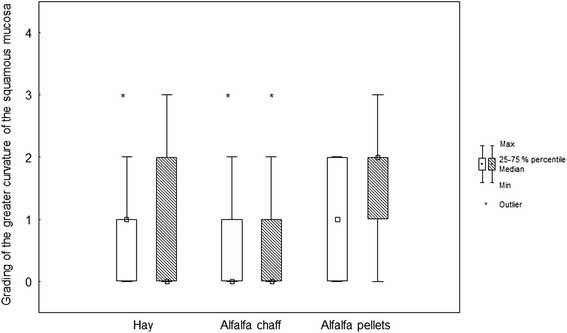
Box (median) and whisker (25th/75th percentiles) plots of lesions grades for the greater curvature of the squamous mucosa before and after weaning for the different feeding protocols (white plots before weaning; striped plots after weaning)
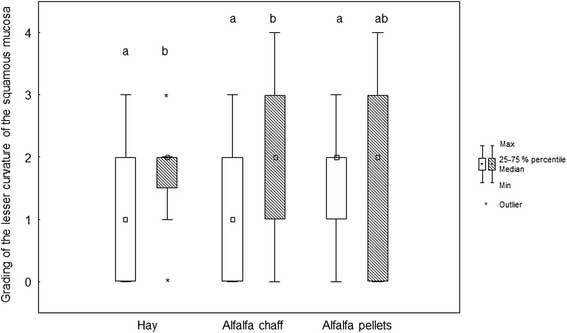
Box (median) and whisker (25th/75th percentiles) plots of lesions grades for the lesser curvature of the squamous mucosa before and after weaning for the different feeding protocols (white plots before weaning; striped plots after weaning). Unlike letters are different with p < 0.05
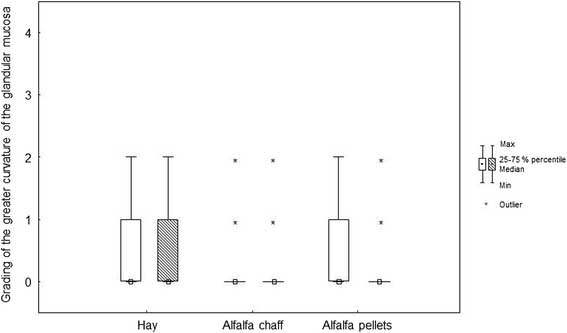
Box (median) and whisker (25th/75th percentiles) plots of lesions grades for the greater curvature of the glandular mucosa before and after weaning for the different feeding protocols (white plots before weaning; striped plots after weaning)
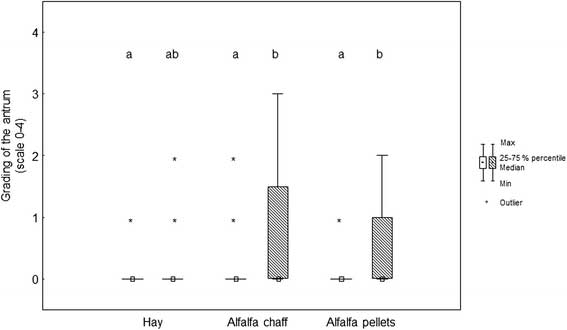
Box (median) and whisker (25th/75th percentiles) plots of lesions grades for the antrum before and after weaning for the different feeding protocols (white plots before weaning; striped plots after weaning). Unlike letters are different with p < 0.05
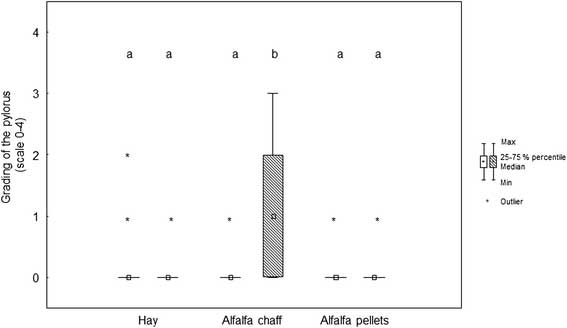
Box (median) and whisker (25th/75th percentiles) plots of lesions grades for the pylorus before and after weaning for the different feeding protocols (white plots before weaning; striped plots after weaning). Unlike letters are different with p < 0.05
Effect of Weaning on Gastric Mucosa
Only very few foals had gastric mucosa lesions in the dorsal squamous fundus before and after weaning in the three diet groups. In the squamous region of the greater curvature, the median lesion score was 1 (0/1) before and 0 (0/2) after weaning in the hay group (p = 0.78), 0 (0/1) before and 0 (0/1) after weaning in the alfalfa chaff group (p = 0.21), and 1 (0/2) before and 2 (1/2) after weaning in the alfalfa pellets group (p = 0.17) (Fig. 1). In the squamous region of the lesser curvature, the median lesion score increased from 1 (0/2) before to 2 (1.75/2) after weaning in the hay group (p = 0.03), increased from 1 (0/2) before to 2 (1/3) after weaning in the alfalfa chaff group (p = 0.02), and was 2 (1/2) before and 2 (0/3) after weaning in the alfalfa pellets group (p = 0.14) (Fig. 2).
In the glandular region of the greater curvature, the median lesion score was 0 (0/1) before and 0 (0/1) after weaning in the hay group (p = 1), 0 (0/0) before and 0 (0/0) after weaning in the alfalfa chaff group (p = 0.48), and 0 (0/1) before and 0 (0/0) after weaning in the alfalfa pellets group (p = 0.35) (Fig. 3). In the antrum, the median lesion score was 0 (0/0) before and 0 (0/0) after weaning in the hay group (p = 0.18), 0 (0/0) before and 0 (0/1) after weaning in the alfalfa chaff group (p = 0.01), and 0 (0/0) before and 0 (0/1) after weaning in the alfalfa pellets group (p = 0.03) (Fig. 4). At the pylorus, the median lesion score was 0 (0/0) before and 0 (0/0) after weaning in the hay group (p = 1), 0 (0/0) before and 1 (0/2) after weaning in the alfalfa chaff group (p < 0.001), and 0 (0/0) before and 0 (0/0) after weaning in the alfalfa pellets group (p = 0.56) (Fig. 5).
Effect of Diet on Gastric Mucosa
Before weaning (T = 0), the gastroscopic findings of each region did not differ significantly between the three diet groups (Table 3). After weaning (T = 16), gastric mucosal lesions at the pylorus were significantly more severe in the group fed alfalfa chaff (p = 0.002) (Fig. 5). In the other regions, no differences related to the feeding regimes were observed.
Effects of Alfalfa Husk and Alfalfa Pellets on the Gastric Mucosa of Weaned Horses(Part 2)
The above is the article for you: Effects of Alfalfa Husk and Alfalfa Pellets on the Gastric Mucosa of Weaned Horses(Part 1). If you are interested in our products or project solutions, please contact us. We will give you the best product quality and the best price. Email: enquiry@pellet-richi.com
Related Product
Production Line Equipment
related News
- >Effects of Alfalfa Husk and Alfalfa Pellets on the Gastric Mucosa
- >What’s the Difference Between Feeding Baled or Pelleted Hay to Ho
- >Lucerne Alfalfa Pellets Are High-quality Feed for Cattle and Horse
- >Alfalfa or Alfalfa Pellets: Which is Better for Horse?
- >Why Does the Cattle Feed Pellet Plant Produce Alfalfa Pellets
Here you can submit any questions and we will get back to you as soon as possible. We will not disclose the information you submit to anyone, please rest assured.
Copyright© 2022 Richi Machinery. All rights reserved. Site Map


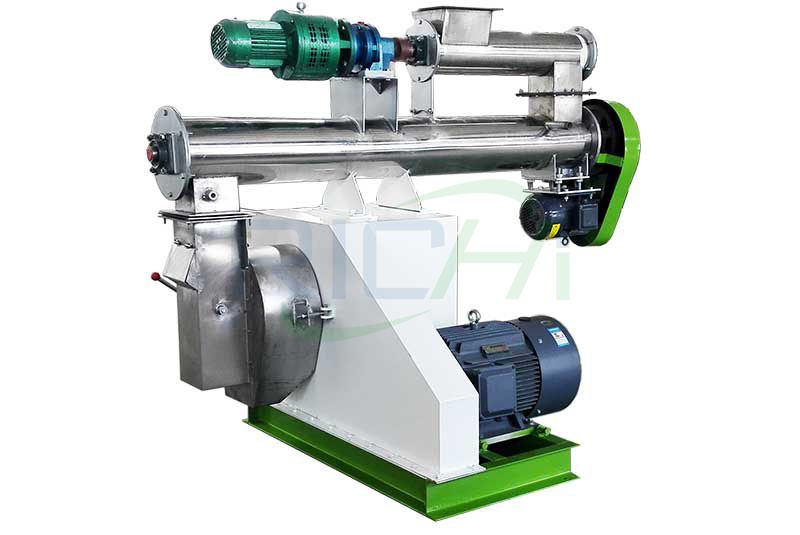
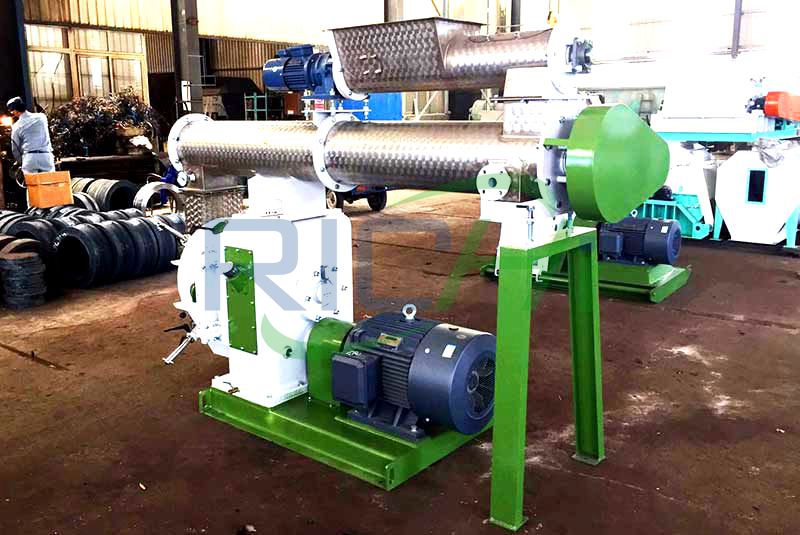
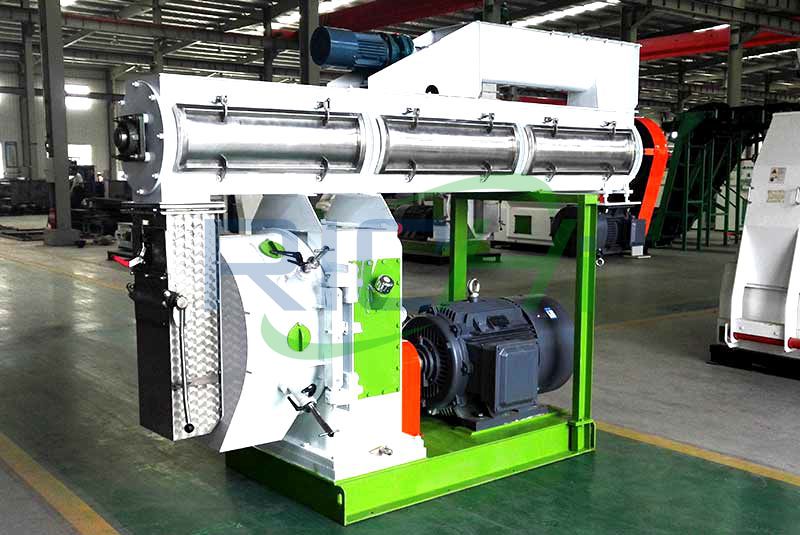
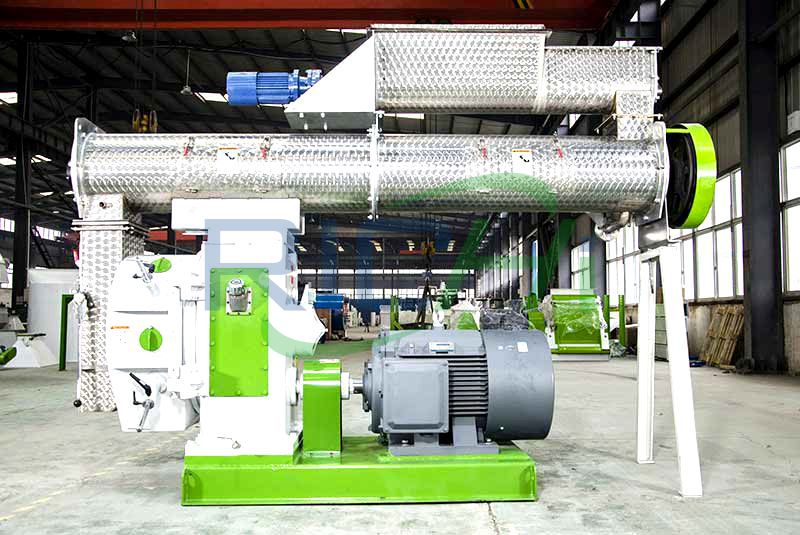
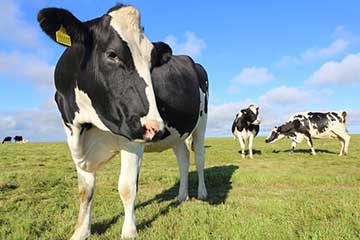
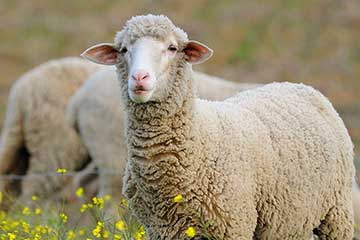
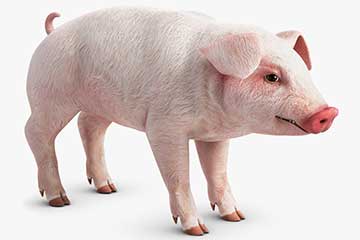

 Product Center
Product Center Get Latest Price
Get Latest Price